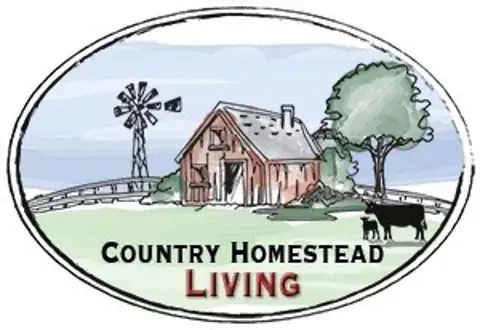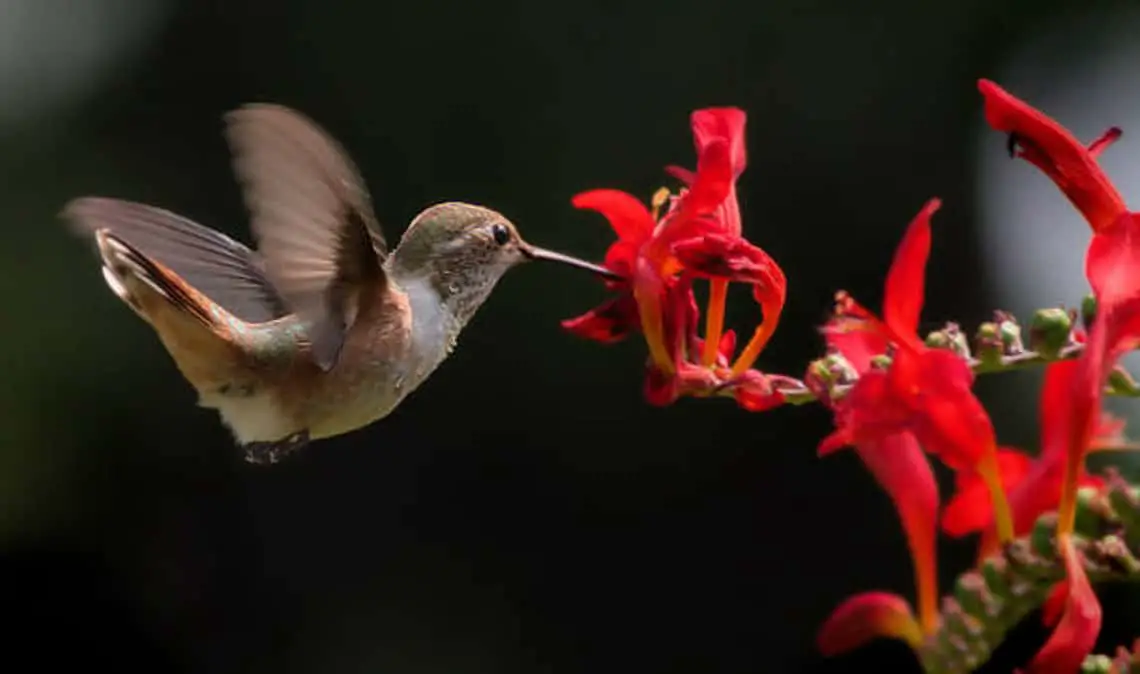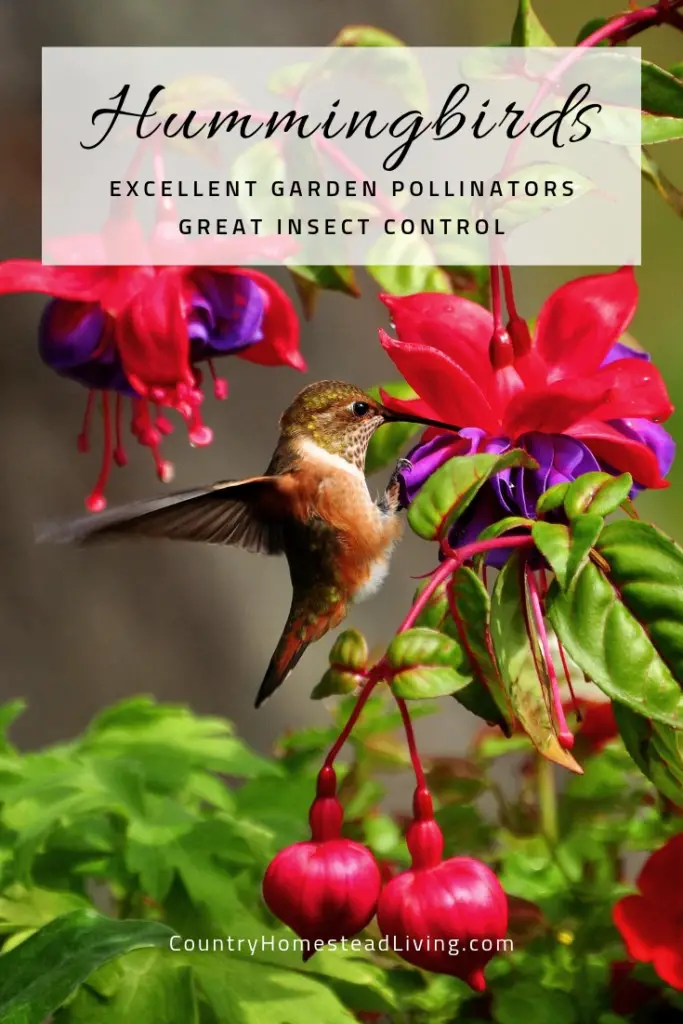In the garden you might catch a glimpse of iridescent feathers reflecting brilliant color as a sunbeam ricochets off a flurry of wings.
This thumb-sized jewel makes the faintest hum as it pauses in the air defying gravity then suddenly plunges head first as it all but disappears into a flower.
But what is it? It’s a hummingbird, a fascinating little creature that darts around the yard like tiny little nectar fiends that delight those of all ages.
Besides being delightful to watch, they are excellent for gardens having benefits you might not have considered for pollination and pest control.
For many years I have enjoyed putting out hummingbird feeders so we can watch these delightful little birds and their antics.
It’s only been in the last few years that I have learned what valuable pollinators and great pest control helpers these little gems are for our garden.
I’d like to introduce to you how they can help you in your gardens too.
Worthwhile Pollinators
Hummingbirds (Trochilidae) or sometimes called hummers, are named for the sound they make with their rapidly undulating wings, also referred to as a wing whistle.
A nectarivorous (feeding on nectar), the hummingbird acquires its energy and nutrient requirements from a diet that is primarily obtained from succulent nectar filled flowers or brightly-colored hummingbird feeders.
Hummingbirds in flight, with the exception of insects, have the highest metabolism of all the animals.
Since their fast heartbeats and breathing require a lot of food and most of their energy is spent while flying, they must eat frequently, dining on nectar to fuel their rapid metabolism.

Since they expend so much energy with the rapid beating of their wings and a heart rate that can reach as many as 1,260 beats per minute, they must consume incredible amounts of nectar each day.
Which is often more than their body weight on a daily basis.
They must visit hundreds of flowers daily in order to consume as much nourishment as they need as they are only hours away from starving.
There’s a strong interrelationship between hummingbirds and the flowers they collect nectar from.
Since hummingbirds need to visit so many flowers each day, they become indispensable little pollinators for your garden.
With their elongated tapered beak, these darling little hummingbirds can pollinate the flowers that can’t be reached by other birds.
It makes it easier to pollinate when growing long-tubed flowers that need pollination since they aren’t disadvantaged with a small beak or large body when it comes to spreading pollen.

When they feed on flowers their forehead rubs against the stamens and pistils collecting pollen.
As they move from flower to flower they wonderfully pollinate as they go.
Insect Population Control
Hummingbirds require a diet that is both an energy source from nectar but also a protein source that comes from small insects.
A garden filled with plants and flowers that hummingbirds love is the safest way you can provide both.
Nectar is essentially simple sugars, sucrose, glucose and fructose which are easily ingested and digested which represent a rich and efficient source of nutrition for these precious birds.
However, while it does contain amino acids and proteins, they are found in low quantities, also severely deficient in minerals and vitamins, thus nectar is an incomplete source of nutrition.
No species of birds consumes nectar exclusively even though nectar feeding is widespread among birds.
For a mixed diet, most nectar feeding birds, including the hummingbird, combine it with insectivory (intentional eating of insects) that provides a source of protein.

Feeding on large quantities of bugs is particularly important during the nesting season as the insects provide essential protein for the growth of hummingbird hatchling chicks.
The mother bird spends her time catching small spiders and insects, feeding the nestlings one to three times an hour.
She will continue to feed the little fledglings for another ten days after they start to fly.
Hummingbirds are fierce little hunters with an incredible sense of hearing that’s sensitive enough to pick up the sounds of an insect on a plant, spending a good portion of their day hunting for insects that they can devour.
Some of the insects these fascinating tiny birds love to feast on are soft-bodied insects such as gnats, aphids, caterpillars, and mosquitoes while also loving to gobble up insect eggs.
While continually dining on nectar, pollen and insects, hummingbirds can help keep the insect population down pretty dramatically as they devour dozens of the unwanted insect pests from your garden every day.
If you love hummingbirds like I do and want to keep them around, it is extremely important to not use any pesticides or insecticides.
It will make these little jewels violently ill and can be fatal to them.
When eating insects, hummingbirds will ingest the poisons when insecticides are used.
Even systemic herbicides can be found in the nectar of flowers so, avoid using insecticides or systemic herbicides in your gardens.
By using chemicals in your garden you will also eliminate many of the insects that these hummingbirds need.
It’s just one of the reasons we don’t use any chemicals in our garden.
Attracting more hummingbirds to your garden will have some natural assistance for controlling insect populations letting these tiny birds do the job of pest control for you.
Hummingbirds hold important benefits that every organic gardener should be aware of.
How Can You Attract Hummingbirds
Even though some gardeners might go years without ever seeing these delightfully small and sweet little birds, most of us can say that these precious little birds often buzz around us as we work in the garden.
I’ve even had the privilege of holding a couple of hummingbirds in my hand as I rescued them when they accidentally flew into the house!

Hummingbirds are always darting around in our garden helping to pollinate and assist with pest control!
Odds are that they are around your garden too if there are spots here and there that attract visits by these hummingbirds.
But if not, here are a couple of ways I attract them by using feeders and making sure I have many colorful flowering plants in our garden.
Feeders To Attract
The most common way people attract hummingbirds is by using low-cost brightly colored plastic hummingbird feeders.
I always make sure to have several hanging around our house as well as in our garden.
This is the hummingbird feeder we have several of (link to read reviews on Amazon) as I’ve found them to be the easiest to fill and clean of all other ones we have used.
If you use a hummingbird feeder it’s really easy to make a homemade nectar of sugar and water.
It’s what I do and it’s so quick and easy to make.
To make your own nectar simply mix four cups of water to one cup of sugar, stirring until the sugar is dissolved.
Some people feel it is important to heat this sugar water on the stove to make sure the sugar is dissolved.
If you do heat it, you need to make sure to let the nectar cool down before pouring it into the hummingbird feeder.
What time of the year to put out hummingbird feeders will depend on your location and the weather.
It can vary from mid to late March to April or even early May in different areas of the United States.
When I start seeing the hummers coming around looking for where they have been used to feeding from our feeders in the past I make some nectar, fill the feeders and hang them up for them.
This way I don’t have feeders out too soon to have the nectar spoil, this method has always worked well for me.

Placing the feeders in a spot that’s not in direct sunlight will help keep the nectar from spoiling so quickly.
Making sure to clean the feeders often will also help keep the nectar from going bad and makes it healthier for the birds.
Hummingbirds like to conserve energy when they can and don’t like to stay out in the open, so keeping feeders about 10 to 15 feet from trees, shrubs or other places for them to hide will keep the birds happy.
Hummingbirds can’t smell so they depend on sight.
While being attracted to red some people might want to use Kool-Aid or a food color dye to color the nectar but this should be avoided as it’s harsh on their systems.
Many feed supply stores sell hummingbird nectar that has been specifically formulated for the nutritional needs of these little birds but beware that some contain red dyes and preservatives that can be dangerous to the birds.
I researched and found that Homestead makes an organic nutritional nectar (link to read reviews on Amazon) that hummingbirds love and isn’t harmful for them.
It’s just as easy to make your own and less expensive but avoid using honey or artificial sweeteners.
Placing several feeders around your house or garden can maximize the number of hummingbirds that visit.
These sweet little birds despite their tiny size, are actually pretty territorial and aggressive so you would benefit by putting up more than one feeder while also keeping them fairly far apart from each other.
Their aggressiveness can come in pretty handy when placing feeders in fruit trees to help keep out the larger birds that like to come and devour your precious fruit that’s hanging on the trees.
Hanging feeders, no matter where you hang them, should be about head high so they are easy to remove for cleaning and refilling them when needed.
Attracting With Flowers
Attracting hummingbirds can also be made easy by planting certain flowers in your garden.
Selecting plants that have blooms throughout more than one season will keep them around longer.
While mostly being attracted to red, a color bees find difficult to see, orange and pink can also attract them but yellow and white blooms don’t necessarily even though they will feed from them sometimes.

They like open flower shapes as well as long tube-shaped flowers that allow their long bills to easily fit into.
The tongue inside their elongated tapered beak allows the birds to feed on the nectar down deep inside flowers which they can consume at a rate of about 13 licks a second.
Some people actually think hummingbirds have tongues that are hollow like a straw.
But instead of straw like, they have grooves on the sides of the tongue that collect the nectar at the lowest point in the tubes of the flowers.
Planting a garden of vibrantly colored flowers that give plenty of nectar the birds need is probably the best superb method and most colorful way to attract the lovely hummers to your property.
A few of the plants that will attract hummingbirds are flowering plants such as Fuchsia, Bee Balm, Honeysuckle, Lantana, Morning Glory, Scarlet Runner Bean, Coral Bells, Butterfly Bush, Hosta, Red Buckeye, Cardinal Flower and Petunias.
Several other plants include the Trumpet Vine, Rose of Sharon, Salvia, Foxglove, Columbine, Hollyhock, Lupine, Phlox, Sage and Bottlebrush.
With so many flowering plants to choose from it makes it hard to decide just which ones to include in your home or garden landscape.

Putting lots of colorful flowering plants in your garden won’t detract these little tiny hummingbirds from the work they do as pest control for your fruits and vegetables.
If anything, it will help to encourage them to stick around a lot more since there’s a ready availability of sweet nectar and insect bug protein they so need.
It might surprise you that with a brain that’s 4.2 percent of their body weight, hummers have the largest brain relative to size of all birds.
Hummingbirds are also one of the smartest birds, they can remember every flower they’ve been to, remember how long each type of flower takes to bloom and where the best ones are.
They have a natural curiosity that inspires them to investigate new brightly-colored nectar-filled hummingbird feeders or new flowering plants in your gardening landscape.
Hummingbirds might show up immediately or it could take a few weeks before they discover your space if you’ve never had them visit before.
But once they do, you will enjoy their lively nature and the many benefits they provide for your garden.
Being remarkable creatures of habit, the same little birds are likely to return year after year once they’ve discovered your yard or garden providing they’ve found their basic needs.
It’s a good idea to provide them with water also by using garden misters (link to read reviews on Amazon), small drip fountains or tiny waterfalls.
They won’t need large bird baths so shallow water of some sort is ideal for them since they like to bathe in a shallow pool of water.
Its not uncommon to see them enjoying a little bath in a pool of water that has collected in a broad leaf after a rain.
Provide a few places for perches the birds can sit on if you don’t have trees around that are within ten or twenty feet of your flowers or feeder spaces.
They love sitting close to their food sources but also like to sunbathe perched with their breasts towards the sun, fluffing themselves out while spreading their tail.

What incredible birds these lovely creatures are that give endless hours of fascinating entertainment and education.
We have definitely seen the benefits in our garden when these little hummers are around and so enjoy their little escapades as we stop to watch them for a couple of minutes.
Its a fantastic idea to do your utmost to attract these intriguing tiny little flying gems to your yard or garden.
We are very glad that we have included them.
Related Questions
Can hummingbirds freeze to death?
It’s not likely.
But, hummingbirds are not able to withstand freezing temperatures for extended periods of time so that’s why they migrate to warmer places.
However, they do have an amazing way to help them survive if unexpected temperatures drop too low for them.
They simply lower their body temperatures up to 50 degrees while also slowing their heartbeats to almost nothing so they can withstand the freezing cold temperatures.
Will hummingbirds nest in a birdhouse?
No, they won’t.
Hummingbirds will not use traditional birdhouses no matter what size, shape or color they might be since they are not cavity nesters.
Abundant trees and protected sheltered areas will give hummingbirds good options for nesting.
They have even been known to nest on things like wires, clotheslines and other unusual locations.
The nests of hummingbirds are built from a variety of materials such as moss, soft plant-down, feathers, spider silk and lichen.
Do hummingbird feeders have to hang?
Hanging a hummingbird feeder approximately five feet up off the ground is the preferred place for them.
It’s advantageous to make sure they are placed where unwelcome guests like squirrels, cats and mice that like to feed on sugar can’t easily get access to the feeders.
What is the smallest bird in the world?
The Bee hummingbird (Mellisuga helenae) is the smallest bird in the world, measuring about 2 inches and weighing only 0.06 ounces.


